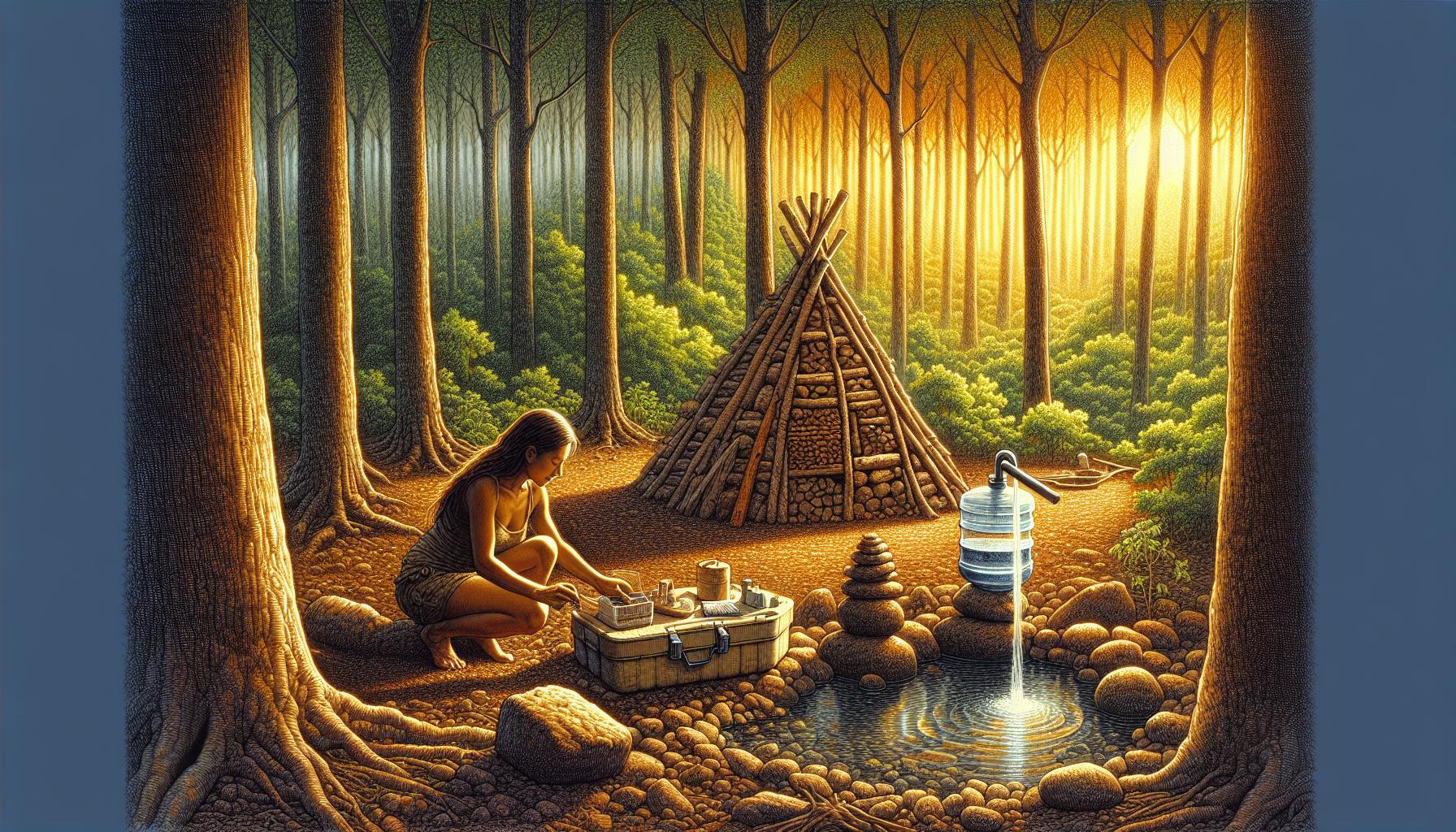Introduction to the Diverse World of Prepping
Disasters can strike without warning, whether through natural catastrophes, technological failures, economic collapse, pandemics, or civil unrest. Being prepared with the right resources and mindset can make the difference between barely surviving a crisis or thriving through it. Prepping refers to the practice of actively making preparations and acquiring key gear to improve readiness and chances of survival in an emergency.
The prepper community encompasses a diverse range of personalities, skillsets, and approaches when it comes to disaster preparedness. By understanding the different survival mentalities within the larger prepper universe, you can learn new perspectives, skills, and strategies while determining the identity that best aligns with your priorities and resources.
In this comprehensive guide, we will explore some of the most common types of preppers, from urban survivors to wilderness experts. Discover what makes each prepper type unique, their specialized gear, and key abilities that enable them to handle risks specific to their environments and lifestyles. Whether you live downtown or off-grid, favor mobility or fortification, or take a minimalist or maximalist approach, embracing prudent preparedness can provide safety and peace of mind for you and your loved ones when faced with the unexpected.
Urban Preppers
Urban preppers reside in cities or suburban areas. Since they live in densely populated environments with limited space and resources compared to rural preppers, urban preppers emphasize adaptability, discreet gear, and mobility in their preparations.
Defining aspects of the urban prepper lifestyle include blending into crowds, learning crucial skills like self-defense and lockpicking, carrying discreet EDC (everyday carry) tools, and staying connected through communications equipment. Rather than relying on isolated bunkers or large stockpiles, they depend on compact bug out bags, strategically placed caches, and highly portable supplies.
Many urban preppers live in apartments or townhomes downtown and often need to get creative when it comes to improvising storage solutions and transforming small living spaces to accommodate emergency preparedness gear. Compared to more isolated rural preppers, most urban preppers are younger or have less hands-on experience with outdoor survival skills.
Key abilities that can prove life-saving for urban dwellers involve navigation through congested city streets and tunnels, finding water sources, and gaining quick entry into buildings for shelter. Examples of specialized gear for the streets include folding knives like the Gerber Flatiron for self-defense, the LifeStraw personal water filter to safely hydrate from questionable sources, Clif Bar energy food for portability, the AlignMed concealed body armor undershirt for discreet protection, and the Uniden handheld radio to stay situationally aware.
Maintaining access to information during crises is crucial for urban preppers, so many also utilize portable radios, satellite phones, police scanners, and Faraday pouches or cages to protect electronics against damaging EMPs in the event of a large-scale attack or solar flare. Having a trusted network of local prepper contacts provides community and support for trading skills, resources, and information.
Wilderness Experts
Wilderness preppers embrace off-grid, rural settings usually far from cities. They possess immense experience with outdoor survival skills gained from a lifetime spent thriving in the forests, mountains, prairies, wetlands, and other rugged natural environments near their homes. Their isolated residences and extensive bug out retreats in remote locations allow for greater self-reliance and freedom from reliance on modern infrastructure and external systems.
With their distrust of government overreach coupled with comfort in solitude, wilderness preppers pride themselves on independence and self-sufficiency. They possess valuable abilities like hunting, trapping, foraging for wild edibles, natural navigation by the stars or terrain, and bushcraft skills for starting fires, building emergency shelters, and crafting tools by hand.
Key gear and weaponry includes rifles for hunting like the Mossberg 464 lever action, knives like the KA-BAR Becker BK2 for camp tasks, portable camping supplies, and two-way radios for communications. Many wilderness preppers own fortified structures integrated into the landscape with sustainable off-grid resources. Secret cache sites stocked with tools and provisions may be buried or hidden throughout the densely forested lands they know so intimately. Their lifetime of localized experience and geographical familiarity in the region gives wilderness experts an advantage for survival and self-reliance.
These preppers focus on adapting to and thriving sans modern amenities through abilities like natural shelter construction, friction fire skills, and edible and medicinal plant identification. Stockpiling firearms and ammunition provides security and enables hunting for sustenance. Overall, the provisions and preparations made by seasoned wilderness preppers are extensive, meticulous, and specially tailored to allow thriving in the forests, mountains, deserts, or prairies they call home.
Homesteaders
Homesteaders lead a sustainable, mostly agrarian lifestyle that embodies resilience and preparedness. They possess agricultural expertise from raising livestock and growing crops, while embracing a self-sufficient philosophy and way of living. Although primarily self-reliant, homesteaders also build community with networks of like-minded homesteaders for bartering goods, sharing knowledge, and exchange of labor.
Through small-scale livestock husbandry, gardening, food preservation techniques like curing and canning, and foraging for wild edibles, homesteaders develop their resilience and reduce reliance on external systems. Common livestock and crops raised include chickens, goats, pigs, cattle, fruits, vegetables, medicinal and culinary herbs, and mushrooms. But dedicated homesteaders also master advanced niche skills like beekeeping, mushroom propagation in logs or bottles, and identifying and transplanting wild native plants.
By growing, raising, preserving, and making the vast majority of their own food, tools, medicine, and other essential supplies, homesteaders mitigate reliance on mainstream commercial systems. Some experienced homesteaders even create entire communities on their land with networks of small cabins, shared agricultural resources, and communal meeting spaces. The homesteading lifestyle provides control over basic provisions and utilizes time-tested, traditional methods modeled after the self-sufficient homesteads of past generations. Passing down sustainable living skills and knowledge cultivates further resilience and independence from broader supply systems.
Doomsday Preppers
Doomsday preppers represent a niche of die-hard survivalists who specifically prepare for high-risk scenarios like all-out nuclear war, global viral pandemics, cyber attacks that disable critical infrastructure, and complete anarchy or societal collapse. Their mindset and measures revolve around being ready for worst-case disasters and extremes.
Massive underground bunkers or fortified homes with years’ worth of food, medical provisions, tools, and more allow doomsday preppers to shelter in place if society crumbles. Extensive stockpiles and caches provide resources to escape unrest by bugging out if needed. Their bunkers may boast reinforced architecture, NBC air filtration systems, hydroponic food growth systems, and off-grid power generation through solar, propane, or generators.
Security is an utmost priority for doomsday preppers, so military-style weaponry often plays a key role in their preparations. Firearms like assault rifles and riot gear help defend homesteads or compounds against thieves and violence. Communications equipment, night vision optics, thermal imaging scopes, remote camera systems, and perimeter alarm systems provide intelligence, early warnings, and capabilities for surveillance and monitoring of their surroundings. Their distrust of outsiders and government coupled with worst-case thinking inspires reclusiveness, secrecy, and willingness to use lethal force if deemed necessary.
While often seen as extremists or fringe elements by some, doomsday preppers' laser focus on security and surviving existential threats makes them well-equipped psychologically and logistically to endure even the most unstable and dangerous times. Those unable or unwilling to adopt such intense measures can still learn useful emergency preparedness and self-reliance principles from understanding the doomsday prepper mindset.
The Minimalist Prepper
Minimalist or stealth preppers take a low-key approach focused on adaptability, mobility, and inconspicuousness. Rather than striving to accumulate vast stockpiles or assets, they keep a low profile with their preparations and avoid standing out through their modest lifestyle. Their flexibility, creativity, and minimalism allows them to prep discreetly.
They favor multi-use EDC tools, bare essential portable supplies, and small, nondescript living spaces like apartments or RVs that blend into most environments. The quality and utility of an item takes priority over quantity or flashy features. To remain agile, minimalist preppers stress skills like improvisation and living off the land over gear and provisions.
Staying inconspicuous and blended into the crowd through their modest homestead, neutral clothing, and unassuming demeanor is key for minimalists to maintain their facade. They avoid wearing overt tactical clothing or equipment that would draw unwanted attention. Yet their discreet and nondescript bags still contain carefully chosen survival tools and EDC essentials.
Minimalist preppers optimize their preparations for fluid, unpredictable situations requiring frequent relocation and adaptation. Backup locations for relocating and distributed resources are arranged in advance within their region. Scouting, foraging, and diverse survival skills allow them to smoothly adapt to various environments if forced to move locations. An under-the-radar network and intimate knowledge of the land both locally and regionally enhances their resilience. Overall, adaptability and mobility take priority for the minimalist over amenities and material possessions.
Comparing Prepper Philosophies
While all preppers share a passion for preparedness, they approach it differently based on their circumstances, environments, skillsets, and mindsets. Here is a comparison of some of the main prepper philosophies:
| Prepper Type | Priorities | Skills | Gear | Security | Locations |
|---|---|---|---|---|---|
| Urban | Blending, mobility, discreet tools | Navigation, self-defense, social | Bug out bag, everyday carry tools | Low profile, allies | City apartments, urban |
| Wilderness | Off-grid living, outdoors skills | Hunting, firecraft, natural navigation | Hunting rifles, camping supplies | Isolation, firearms | Remote cabins and caches |
| Homesteader | Livestock, gardening, food preservation | Agriculture, animal husbandry, crafts | Farm tools, seeds, canning supplies | Community, simplicity | Farms, acreages |
| Doomsday | Surviving disasters, societal collapse | Tactical training, intelligence gathering | Bunkers, stockpiles, heavy weapons | Fortification, lethal force | Secret bunkers and compounds |
| Minimalist | Adaptability, mobility, improvisation | Scouting, foraging, stealth | Multi-use tools, discreet bags | Blending in, inconspicuous | Apartments, vehicles, nature |
Conclusion
Prepping encompasses a diverse spectrum of survival philosophies. While preppers vary in their methods, environments, skillsets, and resources, understanding these different survival mentalities helps us become better prepared in our own right. We can learn useful new perspectives, abilities, gear recommendations and preparedness principles from each of the main prepper types profiled above.
Urban preppers show how tools and adaptable mindsets can ready city dwellers for disasters. Wilderness preppers exemplify rugged self-reliance honed over decades in nature. Homesteaders demonstrate sustainable living through community and agriculture. Doomsday preppers reveal how meticulous planning and provisions can steel people for worst-case scenarios. And minimalist preppers prove preparedness can be cultivated subtly using multi-use gear.
There is no single perfect way to prep. By recognizing our own risks, resources, and environments, we can implement preparedness in a strategic manner optimal for our situation. Regardless of the specific methods used, building skills, supplies, and survival knowledge helps provide safety and peace of mind to get through unexpected emergencies and come out more resilient on the other side.


